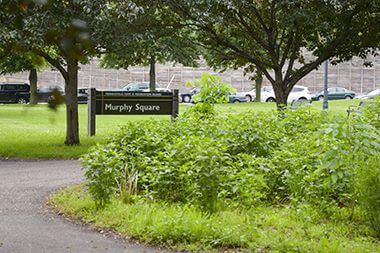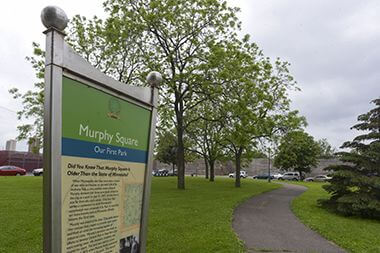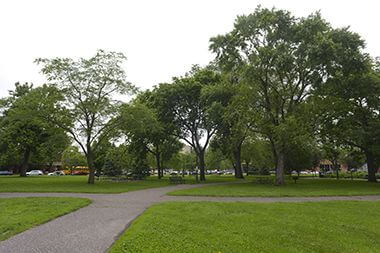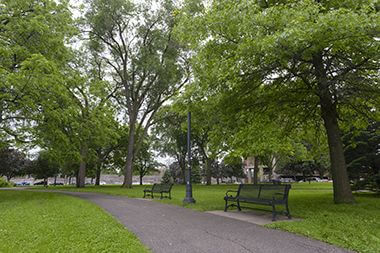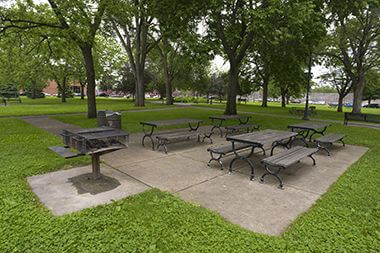Address
801 22nd Ave. S
Minneapolis, MN 55454
Plan Your Route
Contact
Phone: 612-230-6400
Email: info@minneapolisparks.org
Park Hours
6 am-midnight
Ordinance PB-2-33
Features & Amenities
- Drinking Fountain
- Grill
- Picnic Area
Not finding what you’re looking for?
Search Parks & Destinations
Park Projects
See what’s currently in the works for this park. Some projects may be under the name of the regional park or service area it lives within. View Current Projects

Your NPP20 money at work:
Maintenance is increasing at all neighborhood parks, thanks to additional annual funding from the 20-Year Neighborhood Park Plan (NPP20). This initiative also funds ongoing rehabilitation and major project to restore neighborhood parks and help address racial and economic equity.
Park Details
Size: 3.15 acres
Neighborhood: Cedar-Riverside
Service Area: South
Master Plan: After two years of extensive community engagement, the Murphy Square Park Master Plan was approved in 2016 as part of the South Service Area Master Plan. The Murphy Square Park Master Plan will guide outdoor park improvements at Murphy Square Park for the next 20-30 years. Click the link below to view the master plan.
Rentals & Permits
Outdoor Use and Event Space: Learn how to reserve park space for corporate events, community celebrations, and more.
History
Name: The park was named for Edward Murphy who donated the land for a park when he platted Murphy’s Addition in 1857. The name was officially changed from Murphy Park to Murphy Square in 1890.
Acquisition and Development
When Edward Murphy dedicated the land for a park in 1857, parks were in the news. That year New York City conducted a competition to design its vast Central Park, one of the most important developments in the creation of urban parks in the country’s history. That event may have influenced Murphy’s establishment of a park on land he was developing.
Murphy Park was a long ways from the center of the small towns of Minneapolis and St. Anthony at the time and the land served as little more than a cow pasture for twenty years. In 1873 Murphy attempted to get the city council to pay to improve the land. Trees were planted in the park, perhaps under the direction of Charles Loring, who is said to have planted the first trees in Minneapolis and was a city council member at the time. The city council approved an expenditure of $500 for the purpose, but the mayor refused to authorize reimbursement for Murphy after he had paid for the work.
The park was transferred from the city council to the new park board shortly after the park board was created in April 1883. The park board hired Horace Cleveland to create a plan for the park in late 1884.
Murphy Square was one of several parks immediately improved by Theodore Wirth when he was hired in 1906, including additional plantings and changes to the paths in the park. An artesian well was also dug at Murphy Park that year, but the city condemned as unfit the water produced by the well.
Murphy Square was one of the parks recommended as a playground in 1906, when the park board installed its first playground equipment and a merry-go-round was installed in 1907. A tennis court was built at Murphy Square in 1917 at a cost of $400, but was removed in 1919 with the explanation that there wasn’t sufficient space for it.
Some residents of the neighborhood petitioned the park board to install a kittenball (softball) field in the park in 1922, but opposition from other property owners led the park board to reject the idea.
With the growth of Augsburg College, Murphy Square became, in essence, a central square for the college. The park board entered into serious negotiations with Augsburg College to sell the square to the college in 1957. When those negotiations were unsuccessful, the park board included Murphy Square on a list of properties it could part with, for housing purposes, in 1960. In 1975, the park board considered a land swap with Augsburg College that would have transferred the park to the college, but once again the city’s oldest park remained a park.
Ultimately, only a small piece of Murphy Square was lost, and that was due to the construction of the I-94 freeway, which nipped off a bit of the park in the 1960s.
Park history compiled and written by David C. Smith.








